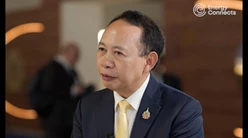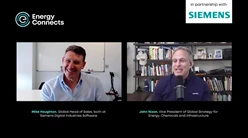Sweden’s Stegra Faces Funding Crunch in Echo of Northvolt
(Bloomberg) -- Low-carbon steel startup Stegra AB was supposed to be a champion of Sweden’s green industrial ambitions. Now the company faces a funding crunch, and is seeking up to €975 million ($1.14 billion) in new financing to cover higher than expected project costs, fund infrastructure and fill a gap left by delays to state grant support.
Stegra is one of a number of new steelmakers seeking to overhaul one of the most polluting industries in the world, and a bellwether for the sector’s green transition. It’s building its first plant in the very north of the country, near where the now-bankrupt Northvolt AB attempted to make batteries for electric vehicles. Sharing a key investor and funding model, Stegra has continued to insist it has little in common with the defunct battery maker.
But echoes of Northvolt’s tale are starting to show, as Stegra tries to reassure its stakeholders, which include pension funds, commercial banks and public lenders, that it can remain viable. Over the past four years, Stegra has raised about €6.5 billion.
Events came to a head late on Tuesday afternoon when Stegra’s chief executive, Henrik Henriksson, and CFO, Otto Gernandt, hosted a call for investors to assure them the company was confident of securing the money it needed, a person who was on the call told Bloomberg. They asked not to be identified because the discussions were private. Stegra insisted that the company was not focusing on insolvency, contrasting with a report by the Financial Times a day earlier.
Some major investors, including Swedish financier Harald Mix’s Kallskar AB, Altor Equity Partners AB and FAM AB have said they will commit funds to the new round. However, some minority shareholders said that they won’t join in the fundraising, at least for the time being.
Georgi Ganev, chief executive of Kinnevik AB, which has a 3% stake in Stegra, said on an analyst call on Oct. 16 that the investment firm hasn’t participated in the round, and would “wait and see how this shakes out” before committing any further funding. Two other minority shareholders said they also won’t add to their investment, according to people familiar with the matter, who asked not to be identified in order to discuss a private matter. One said that they had lost confidence in Stegra.
Stegra spokeswoman Karin Hallstan told Bloomberg the company was looking at opportunities within public support, equity and loans but declined to provide further details.
In an email to Bloomberg News, Stegra’s Henriksson said he didn’t recognize “the very one-sided picture conveyed” by the FT’s report, and that he was confident that the funding round would succeed.
Steelmaking, which has relied largely on the same production techniques for more than a century, accounts for about 7% of global carbon emissions. Stegra will largely use hydrogen made with renewables rather than fossil fuels in its production process.
When the first phase of Stegra’s plant is finished, it is expected to produce 2.5 million tonnes of green steel per year. The company chose the north of Sweden as its base to take advantage of relatively cheap electricity.
However, the company has delayed the start of production several times, most recently pushing it back three months from its previous guidance of the second half of 2026. About 60% of the plant is complete, according to this week’s statement.
Construction and personnel costs spiked during 2024, resulting in an operating loss of 2 billion kronor ($211 million), according to the company’s latest annual report. The company lost 657 million kronor the previous year. In July, CEO Henriksson described the cost trajectory as satisfactory and said it was moving “according to plan.”
BloombergNEF analyst Claire Curry said that upwards revisions to cost estimates are “probably quite normal” in a “first of a kind” project like Stegra’s.
However, the project costs have increased further because the company is building its own railway and port infrastructure.
The company has also blamed the Swedish government for some of its funding shortfall, Curry added.
The government had initially awarded Stegra €265 million in funding but only distributed €100m, denying it the rest because they said the project’s emissions were above the level approved by the Swedish Environmental Agency.
Stegra is part of a cluster of ventures backed by Vargas Holding AB, a Swedish impact investor founded by Mix and Carl-Erik Lagercrantz. Northvolt, its other major industrial bet, filed for bankruptcy earlier this year after expanding too fast and running out of cash.
Christian Sandstrom, an economics and engineering associate professor from Chalmers University of Technology, who has written a book on Northvolt, described Stegra’s financing as “nested” — a mix of interlocking loans, guarantees, investments and public subsidies that can unravel if a single link gives way, adding that Northvolt’s funding was built the same way.
Henriksson said in June that Stegra is different from Northvolt, even though there are similarities in the funding model with supply contracts used as collateral.
Stegra has now hired US investment bank PJT Partners as a financial adviser, according to a report by Swedish business outlet Affarsvarlden. PJT, known for its work on corporate restructurings, has previously been brought in when companies face financial distress — including by lenders to Northvolt shortly before the battery maker filed for Chapter 11 protection in the US.
Stegra spokesperson Hallstan declined to comment on the appointment, saying only that the company worked with a few different advisors in various parts of the project.
Stegra’s new funding challenges come only a few months after its CEO talked about a potential listing.

Stegra’s struggles don’t just have consequences for equity and debt investors.
The municipality of Boden, where the plant is located, has taken on a huge bet itself, investing in infrastructure and services to be able to accommodate thousands of workers and their families.
The town of just 28,000 people had debts of 1.56 billion kronor as of May this year and that number is seen ballooning to about 2.5 billion kronor by 2028, according to its Strategic Plan. That’s up from less than 100 million kronor in 2017.
Sandstrom, a vocal critic of Northvolt and Stegra, believes the company’s problems are fundamental. “Stegra is trying to inflate a leaky system — the structure looks solid, but the air keeps escaping,” he said. “They can only keep it up for so long.”
But the company’s backer, Mix, said that he thinks the company’s position is strong. Demand for green steel is rising, energy prices are falling, and competition is reducing. “The need for additional financing in the project is due to an expanded investment scope as well as inflation-driven cost increases, which have also impacted several of our industry peers,” he said.
©2025 Bloomberg L.P.





